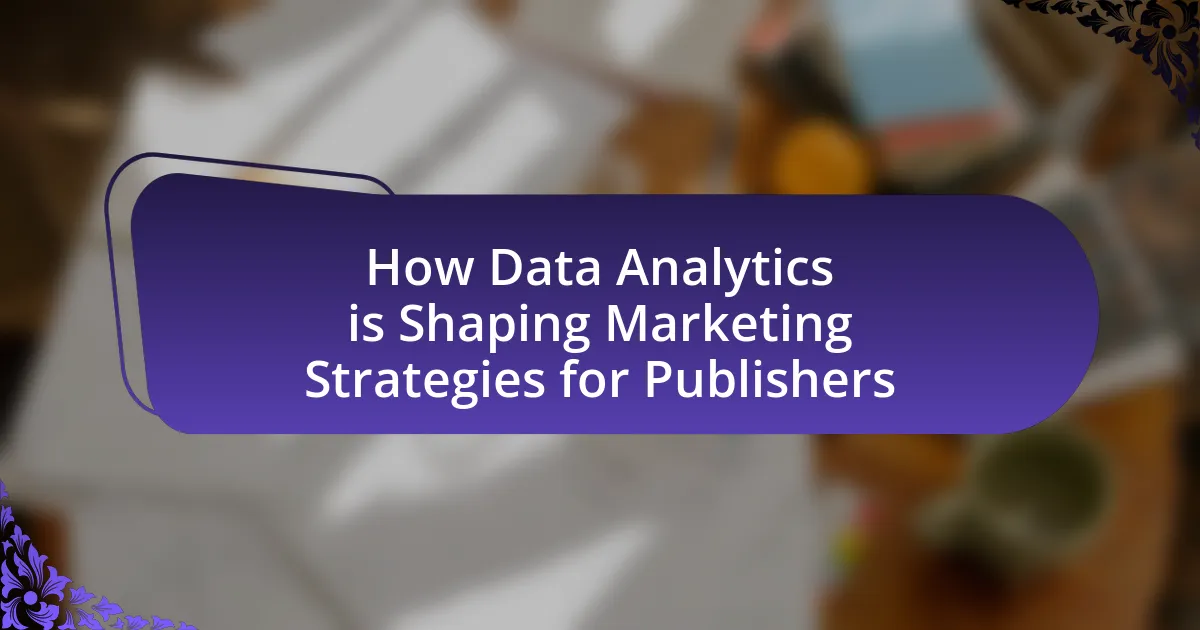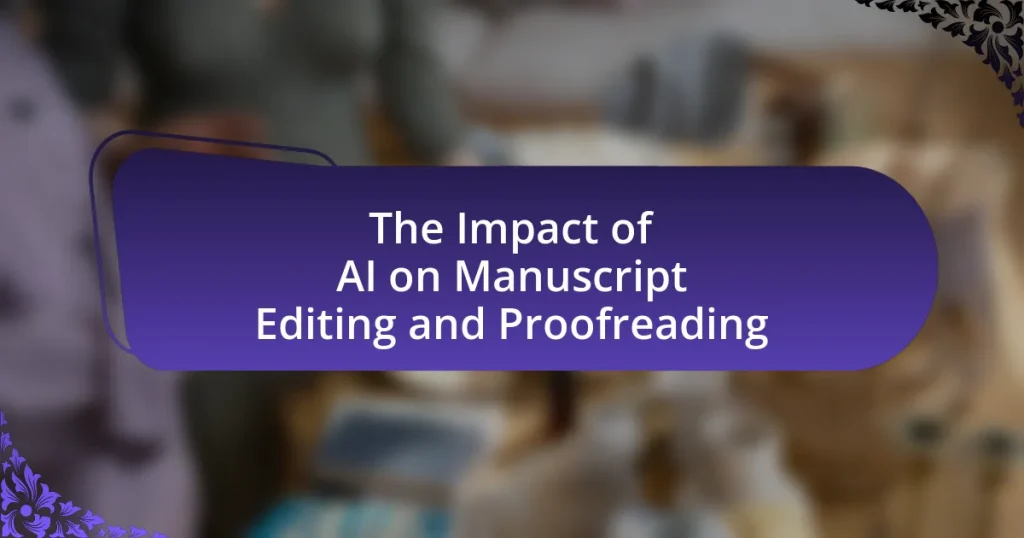Data analytics is fundamentally transforming marketing strategies for publishers by facilitating data-driven decision-making that enhances audience targeting and engagement. The article explores the critical role of data analytics in modern publishing, detailing how publishers collect and analyze data to optimize content and advertising strategies. Key benefits include improved audience targeting, increased engagement, and enhanced ROI on marketing campaigns. Additionally, the article addresses challenges publishers face in integrating data analytics, such as data privacy concerns and technological barriers, while providing practical steps for effective implementation. Emerging trends, including the use of AI and machine learning, are also discussed as pivotal in shaping the future of marketing in the publishing industry.
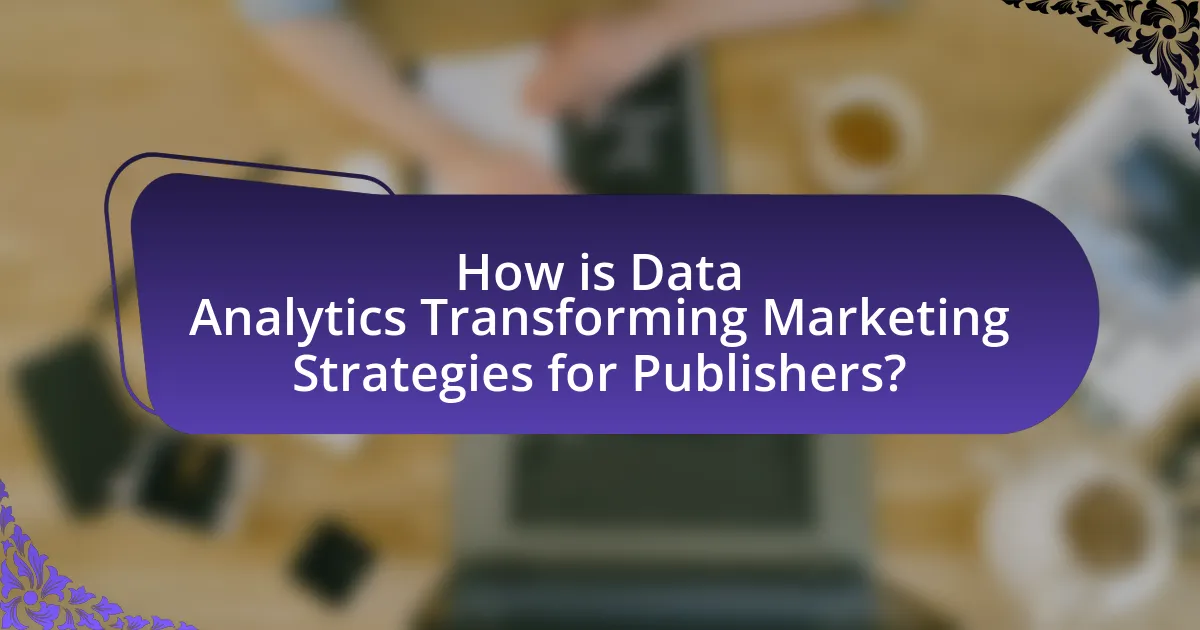
How is Data Analytics Transforming Marketing Strategies for Publishers?
Data analytics is transforming marketing strategies for publishers by enabling data-driven decision-making that enhances audience targeting and engagement. Publishers can analyze reader behavior, preferences, and demographics through data analytics tools, allowing them to tailor content and advertising strategies effectively. For instance, a study by McKinsey found that organizations leveraging data analytics can improve their marketing ROI by 15-20%. This capability allows publishers to optimize their campaigns in real-time, ensuring that they reach the right audience with the right message at the right time, ultimately leading to increased subscriptions and ad revenue.
What role does data analytics play in modern publishing marketing?
Data analytics plays a crucial role in modern publishing marketing by enabling publishers to understand audience behavior and preferences. This understanding allows for targeted marketing strategies that enhance engagement and increase sales. For instance, data analytics tools can track reader interactions, such as which articles are most read or shared, providing insights that inform content creation and promotional efforts. According to a report by the Pew Research Center, 70% of publishers that utilize data analytics report improved audience targeting and engagement, demonstrating the effectiveness of data-driven strategies in optimizing marketing efforts.
How do publishers collect and analyze data for marketing purposes?
Publishers collect and analyze data for marketing purposes through various methods, including website analytics, customer surveys, and social media monitoring. Website analytics tools, such as Google Analytics, track user behavior, demographics, and engagement metrics, allowing publishers to understand audience preferences and optimize content accordingly. Customer surveys provide direct feedback on reader interests and satisfaction, while social media monitoring tools analyze engagement and sentiment around content, helping publishers tailor their marketing strategies. According to a 2021 report by the Interactive Advertising Bureau, 70% of publishers utilize data analytics to enhance audience targeting and improve advertising effectiveness, demonstrating the critical role of data in shaping marketing strategies.
What types of data are most valuable for publishers in marketing?
The most valuable types of data for publishers in marketing include audience demographics, engagement metrics, and content performance analytics. Audience demographics provide insights into the characteristics of the readership, such as age, gender, and location, which help tailor marketing strategies effectively. Engagement metrics, such as click-through rates and time spent on content, indicate how well the audience interacts with published material, guiding content optimization. Content performance analytics, including shares and comments, reveal which topics resonate most with readers, enabling publishers to focus on high-impact content. These data types collectively enhance targeting and improve marketing ROI, as evidenced by studies showing that personalized marketing based on audience data can increase conversion rates by up to 10%.
Why is data-driven decision-making crucial for publishers?
Data-driven decision-making is crucial for publishers because it enables them to optimize content, enhance audience engagement, and increase revenue. By analyzing data on reader preferences, publishers can tailor their offerings to meet specific audience needs, leading to higher retention rates and improved user satisfaction. For instance, a study by the Pew Research Center found that 73% of publishers who utilized data analytics reported increased audience engagement. This evidence underscores the importance of leveraging data to inform strategic decisions, ensuring that publishers remain competitive in a rapidly evolving digital landscape.
How does data analytics improve targeting and segmentation?
Data analytics improves targeting and segmentation by enabling marketers to analyze consumer behavior and preferences through data-driven insights. By leveraging large datasets, marketers can identify distinct audience segments based on demographics, interests, and purchasing patterns. For instance, a study by McKinsey & Company found that companies using advanced analytics for customer segmentation can increase their marketing ROI by 15-20%. This precision in targeting allows for more personalized marketing strategies, enhancing engagement and conversion rates.
What impact does data analytics have on ROI for marketing campaigns?
Data analytics significantly enhances ROI for marketing campaigns by enabling precise targeting and measurement of campaign effectiveness. By analyzing consumer behavior and preferences, marketers can tailor their strategies to reach the right audience, resulting in higher conversion rates. For instance, a study by McKinsey found that companies using data-driven marketing strategies can achieve a 15-20% increase in ROI compared to those that do not. This demonstrates that leveraging data analytics not only optimizes marketing efforts but also maximizes financial returns.
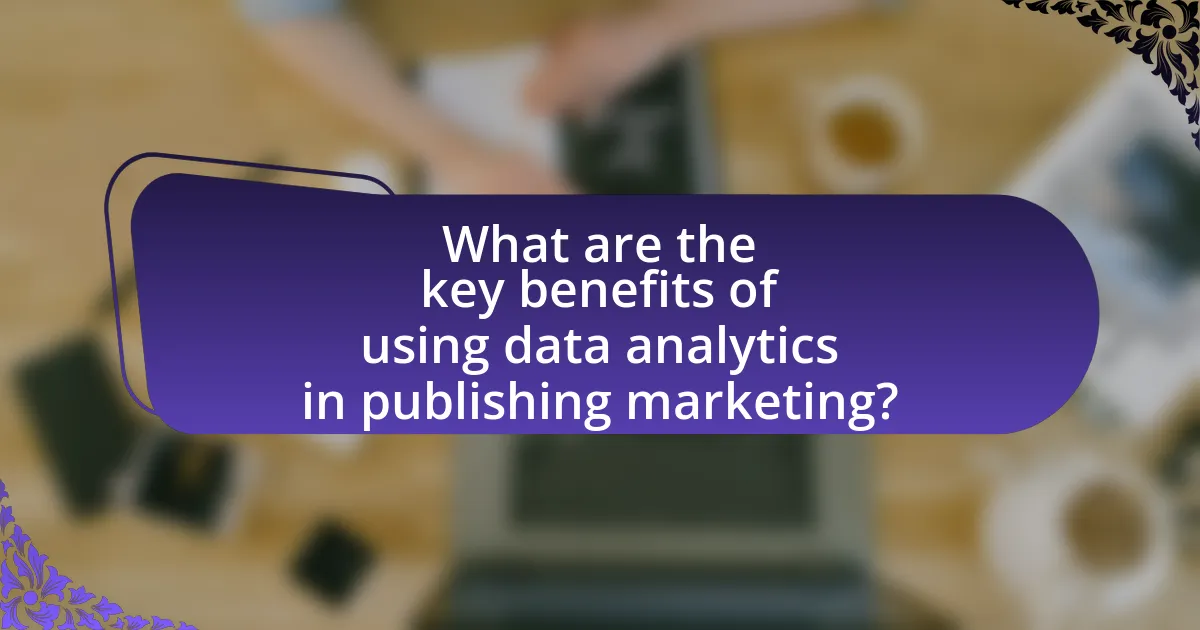
What are the key benefits of using data analytics in publishing marketing?
The key benefits of using data analytics in publishing marketing include enhanced audience targeting, improved content personalization, and increased ROI on marketing campaigns. Enhanced audience targeting allows publishers to identify specific demographics and preferences, leading to more effective marketing strategies. Improved content personalization enables publishers to tailor their offerings to individual reader interests, resulting in higher engagement rates. Increased ROI is achieved through data-driven decision-making, which optimizes marketing spend and maximizes conversion rates. According to a report by McKinsey, companies that leverage data analytics can improve their marketing ROI by 15-20%.
How does data analytics enhance customer engagement for publishers?
Data analytics enhances customer engagement for publishers by providing insights into reader behavior and preferences. By analyzing data such as reading patterns, demographics, and content interactions, publishers can tailor their offerings to meet the specific interests of their audience. For instance, a study by McKinsey & Company found that companies using data-driven marketing strategies can increase their engagement rates by 20% or more. This targeted approach allows publishers to create personalized content recommendations, optimize marketing campaigns, and improve overall user experience, leading to higher retention and satisfaction among readers.
What strategies can publishers implement to leverage data for engagement?
Publishers can implement strategies such as personalized content recommendations, targeted advertising, and audience segmentation to leverage data for engagement. Personalized content recommendations utilize algorithms to analyze user behavior and preferences, leading to higher engagement rates; for instance, platforms like Netflix have reported increased viewer retention through tailored suggestions. Targeted advertising allows publishers to deliver relevant ads based on user data, enhancing click-through rates; research indicates that targeted ads can achieve a 50% higher engagement rate compared to non-targeted ads. Audience segmentation involves categorizing users based on demographics and interests, enabling publishers to create more relevant content and marketing campaigns, which can result in a 20% increase in user interaction. These strategies demonstrate how data analytics can effectively enhance engagement for publishers.
How can data analytics help in personalizing marketing efforts?
Data analytics can significantly enhance the personalization of marketing efforts by enabling businesses to understand consumer behavior and preferences. By analyzing data from various sources, such as social media interactions, purchase history, and website engagement, marketers can create targeted campaigns that resonate with specific audience segments. For instance, a study by McKinsey & Company found that companies using advanced analytics to personalize their marketing can achieve a 10-20% increase in sales. This demonstrates that data-driven insights lead to more relevant messaging and improved customer experiences, ultimately driving higher conversion rates.
What challenges do publishers face when integrating data analytics?
Publishers face several challenges when integrating data analytics, including data privacy concerns, the complexity of data integration, and the need for skilled personnel. Data privacy regulations, such as GDPR, impose strict guidelines on how publishers can collect and use consumer data, which can limit their analytics capabilities. Additionally, the integration of disparate data sources often requires sophisticated technology and expertise, making it difficult for publishers to create a cohesive analytics strategy. Furthermore, the shortage of skilled data analysts and data scientists in the workforce hampers publishers’ ability to effectively interpret and leverage data insights for marketing strategies. These challenges collectively hinder the successful implementation of data analytics in the publishing industry.
How can publishers overcome data privacy concerns in analytics?
Publishers can overcome data privacy concerns in analytics by implementing robust data protection measures and ensuring transparency with users. By adopting privacy-centric frameworks such as GDPR and CCPA, publishers can establish trust and comply with legal requirements. For instance, utilizing anonymization techniques allows publishers to analyze user behavior without compromising individual identities. Furthermore, providing clear privacy policies and obtaining explicit consent from users enhances transparency and fosters a positive relationship. According to a study by the International Association of Privacy Professionals, organizations that prioritize data privacy see a 20% increase in customer trust, which directly impacts engagement and retention rates.
What technological barriers exist for publishers in adopting data analytics?
Publishers face several technological barriers in adopting data analytics, including inadequate infrastructure, lack of skilled personnel, and data privacy concerns. Inadequate infrastructure often results from outdated systems that cannot support advanced analytics tools, limiting the ability to process and analyze large datasets effectively. Additionally, the shortage of skilled personnel, such as data scientists and analysts, hinders the implementation of data-driven strategies, as publishers struggle to find qualified individuals who can interpret complex data. Furthermore, data privacy concerns arise from stringent regulations like GDPR, which complicate data collection and usage, making publishers hesitant to fully embrace analytics. These barriers collectively impede the effective integration of data analytics into marketing strategies for publishers.
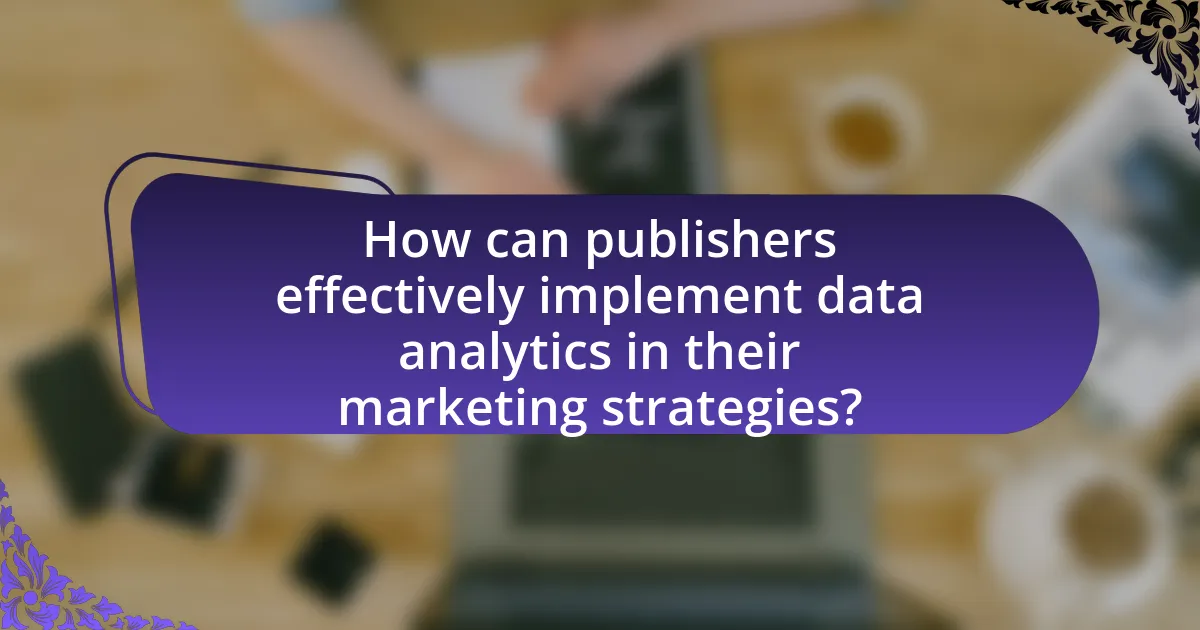
How can publishers effectively implement data analytics in their marketing strategies?
Publishers can effectively implement data analytics in their marketing strategies by leveraging audience insights to tailor content and optimize campaigns. By utilizing tools like Google Analytics and social media analytics, publishers can track user behavior, engagement metrics, and demographic data, allowing them to identify trends and preferences. For instance, a study by the Content Marketing Institute found that 70% of marketers use data analytics to improve their content strategy, demonstrating its effectiveness in enhancing audience targeting and engagement. This data-driven approach enables publishers to make informed decisions, allocate resources efficiently, and ultimately increase ROI on their marketing efforts.
What best practices should publishers follow for data analytics implementation?
Publishers should follow best practices such as defining clear objectives, ensuring data quality, and leveraging advanced analytics tools for effective data analytics implementation. Clear objectives guide the analytics process, allowing publishers to focus on specific goals like audience engagement or revenue growth. Ensuring data quality is crucial, as accurate and reliable data leads to better insights; studies show that poor data quality can cost organizations up to 30% of their revenue. Utilizing advanced analytics tools, such as machine learning algorithms, enables publishers to uncover deeper insights and trends, enhancing decision-making and marketing strategies.
How can publishers ensure data quality and accuracy in their analytics?
Publishers can ensure data quality and accuracy in their analytics by implementing rigorous data validation processes and utilizing reliable data sources. Establishing a systematic approach to data collection, such as using standardized metrics and consistent methodologies, helps minimize discrepancies. Additionally, employing automated tools for data cleansing can identify and rectify errors in real-time, enhancing overall data integrity. Research indicates that organizations that prioritize data quality see a 15% increase in decision-making efficiency, underscoring the importance of accurate analytics in shaping effective marketing strategies.
What tools and technologies are recommended for publishers to use?
Recommended tools and technologies for publishers include content management systems (CMS) like WordPress and Drupal, analytics platforms such as Google Analytics and Adobe Analytics, and marketing automation tools like HubSpot and Mailchimp. These tools enable publishers to efficiently manage content, track audience engagement, and automate marketing efforts. For instance, Google Analytics provides insights into user behavior, allowing publishers to tailor their strategies based on data-driven decisions. Additionally, marketing automation tools streamline communication and enhance audience targeting, which is crucial for effective marketing strategies in the publishing industry.
What future trends in data analytics should publishers be aware of?
Publishers should be aware of the increasing integration of artificial intelligence and machine learning in data analytics, which enhances predictive analytics and personalization. These technologies enable publishers to analyze vast amounts of data quickly, allowing for more accurate audience segmentation and targeted marketing strategies. According to a report by McKinsey, companies that leverage AI in their marketing efforts can see a 10-20% increase in sales. Additionally, the rise of real-time data analytics is crucial, as it allows publishers to make immediate adjustments to their strategies based on current consumer behavior, leading to improved engagement and conversion rates.
How will advancements in AI and machine learning impact publishing marketing?
Advancements in AI and machine learning will significantly enhance publishing marketing by enabling more precise audience targeting and personalized content delivery. These technologies analyze vast amounts of data to identify reader preferences and behaviors, allowing publishers to tailor their marketing strategies effectively. For instance, AI algorithms can segment audiences based on their reading habits, leading to targeted advertising that increases engagement rates. According to a report by McKinsey, companies that leverage AI for marketing can achieve up to a 30% increase in marketing efficiency. This data-driven approach not only optimizes resource allocation but also improves conversion rates, making marketing efforts more effective and measurable.
What emerging data sources should publishers consider for analytics?
Publishers should consider social media engagement metrics, user-generated content, and IoT data as emerging data sources for analytics. Social media engagement metrics provide insights into audience preferences and behaviors, allowing publishers to tailor content effectively. User-generated content, such as comments and reviews, offers direct feedback and can enhance understanding of audience sentiment. IoT data, from connected devices, can reveal user interactions and preferences in real-time, enabling more personalized marketing strategies. These sources are increasingly relevant as they reflect real-time audience engagement and preferences, which are crucial for shaping effective marketing strategies.
What practical steps can publishers take to start leveraging data analytics?
Publishers can start leveraging data analytics by implementing a structured data collection strategy. This involves identifying key performance indicators (KPIs) relevant to their audience engagement, such as website traffic, reader demographics, and content performance metrics. By utilizing tools like Google Analytics and social media insights, publishers can gather actionable data that informs their marketing strategies.
For instance, a study by the Pew Research Center found that 70% of publishers who utilized data analytics reported improved audience targeting and engagement. This demonstrates the effectiveness of data-driven decision-making in enhancing marketing outcomes. Additionally, publishers should invest in training their teams on data interpretation and analysis to ensure they can effectively utilize the insights gained from their analytics efforts.
